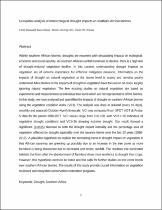JavaScript is disabled for your browser. Some features of this site may not work without it.
- ResearchSpace
- →
- Research Publications/Outputs
- →
- Journal Articles
- →
- View Item
| dc.contributor.author |
Cho, Moses A

|
|
| dc.contributor.author |
Chirwa, PW

|
|
| dc.contributor.author |
Marumbwa, FM

|
|
| dc.date.accessioned | 2021-03-15T15:04:54Z | |
| dc.date.available | 2021-03-15T15:04:54Z | |
| dc.date.issued | 2021-01 | |
| dc.identifier.citation | Cho, M.A., Chirwa, P. & Marumbwa, F. 2021. Geospatial analysis of meteorological drought impact on Southern Africa biomes. <i>International Journal of Remote Sensing, 42(6).</i> http://hdl.handle.net/10204/11896 | en_ZA |
| dc.identifier.issn | 0143-1161 | |
| dc.identifier.issn | 1366-5901 | |
| dc.identifier.uri | http://hdl.handle.net/10204/11896 | |
| dc.description.abstract | Within Southern African biomes, droughts are recurrent with devastating impacts on ecological, economic, and human wellbeing. In this context, understanding the drought impact on vegetation is of extreme importance. However, information on drought impact on natural vegetation at the biome level is scanty and remains poorly understood. Most studies of drought impact on vegetation have largely focussed on crops. The few existing studies on natural vegetation are based on experiments and field measurements at individual tree level which are not representative of biomes. In this study, we mapped the spatial extent and severity of drought using the Standardized Precipitation Evapotranspiration Index (SPEI) and then quantified the drought impact on Southern African biomes using the Vegetation Condition Index (VCI) for the period 1998 to 2017. To compare drought impact across the biomes, we computed the percentage area of the biome with seasonal VCI <30. The drought trend for each biome was computed for each pixel using a linear regression model in R software using the seasonal VCI images from 1998 to 2017. Our result showed that extreme drought impact on vegetation was mainly confined to the southwestern biomes (i.e. the Nama karoo and desert biomes) with most drought occurring during the first half of the season. We also observed an increasing trend of VCI (1998 to 2017) across all biomes and this increasing VCI trend might be explained by woody encroachment which is prevalent in the Savannah and Grassland biomes. The results of this study provide baseline information on drought hotspots. | en_US |
| dc.format | Fulltext | en_US |
| dc.language.iso | en | en_US |
| dc.relation.uri | https://doi.org/10.1080/01431161.2020.1851799 | en_US |
| dc.relation.uri | https://www.tandfonline.com/doi/full/10.1080/01431161.2020.1851799 | en_US |
| dc.source | International Journal of Remote Sensing, 42(6) | en_US |
| dc.subject | Southern Africa biomes | en_US |
| dc.subject | Geospatial analysis | en_US |
| dc.title | Geospatial analysis of meteorological drought impact on Southern Africa biomes | en_US |
| dc.type | Article | en_US |
| dc.description.pages | 2155-2173 | en_US |
| dc.description.note | Due to copyright restrictions, the attached PDF file only contains the preprint verion of the published item. For access to the published item, please consult the publisher's website: https://doi.org/10.1080/01431161.2020.1851799 | en_US |
| dc.description.cluster | Advanced Agriculture & Food | en_US |
| dc.description.impactarea | Precision Agriculture | en_US |
| dc.identifier.apacitation | Cho, M. A., Chirwa, P., & Marumbwa, F. (2021). Geospatial analysis of meteorological drought impact on Southern Africa biomes. <i>International Journal of Remote Sensing, 42(6)</i>, http://hdl.handle.net/10204/11896 | en_ZA |
| dc.identifier.chicagocitation | Cho, Moses A, PW Chirwa, and FM Marumbwa "Geospatial analysis of meteorological drought impact on Southern Africa biomes." <i>International Journal of Remote Sensing, 42(6)</i> (2021) http://hdl.handle.net/10204/11896 | en_ZA |
| dc.identifier.vancouvercitation | Cho MA, Chirwa P, Marumbwa F. Geospatial analysis of meteorological drought impact on Southern Africa biomes. International Journal of Remote Sensing, 42(6). 2021; http://hdl.handle.net/10204/11896. | en_ZA |
| dc.identifier.ris | TY - Article AU - Cho, Moses A AU - Chirwa, PW AU - Marumbwa, FM AB - Within Southern African biomes, droughts are recurrent with devastating impacts on ecological, economic, and human wellbeing. In this context, understanding the drought impact on vegetation is of extreme importance. However, information on drought impact on natural vegetation at the biome level is scanty and remains poorly understood. Most studies of drought impact on vegetation have largely focussed on crops. The few existing studies on natural vegetation are based on experiments and field measurements at individual tree level which are not representative of biomes. In this study, we mapped the spatial extent and severity of drought using the Standardized Precipitation Evapotranspiration Index (SPEI) and then quantified the drought impact on Southern African biomes using the Vegetation Condition Index (VCI) for the period 1998 to 2017. To compare drought impact across the biomes, we computed the percentage area of the biome with seasonal VCI <30. The drought trend for each biome was computed for each pixel using a linear regression model in R software using the seasonal VCI images from 1998 to 2017. Our result showed that extreme drought impact on vegetation was mainly confined to the southwestern biomes (i.e. the Nama karoo and desert biomes) with most drought occurring during the first half of the season. We also observed an increasing trend of VCI (1998 to 2017) across all biomes and this increasing VCI trend might be explained by woody encroachment which is prevalent in the Savannah and Grassland biomes. The results of this study provide baseline information on drought hotspots. DA - 2021-01 DB - ResearchSpace DP - CSIR J1 - International Journal of Remote Sensing, 42(6) KW - Southern Africa biomes KW - Geospatial analysis LK - https://researchspace.csir.co.za PY - 2021 SM - 0143-1161 SM - 1366-5901 T1 - Geospatial analysis of meteorological drought impact on Southern Africa biomes TI - Geospatial analysis of meteorological drought impact on Southern Africa biomes UR - http://hdl.handle.net/10204/11896 ER - | en_ZA |
| dc.identifier.worklist | 24402 | en_US |






